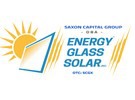Saxon Capital Group has validated the Energy Glass Solar™ Electrical Producing Panels to power greenhouses passively for the production of produce, plants, cannabis, and other crops.
"The Energy Glass Solar panels have demonstrated their efficacy in maintaining optimal greenhouse conditions without compromising plant growth, development, or the pollination process," the Saxon team says. "The electric-producing panels not only provided sufficient energy for greenhouse operations but also did so in a manner that was harmonious with the natural growth cycles of the tomato crop. This alignment of renewable energy technology with agricultural best practices offers a promising avenue for sustainable and efficient farming practices."
The validation trial was performed by Tecnova Centro Tecnologico-Spain. The objective of this trial was to evaluate the agronomic effects produced by Energy Glass Solar photovoltaic panels during a tomato crop developed in a greenhouse. The execution of this trial has been developed in two multispan greenhouses with a total cultivated area of 5,381.9 square feet for each one. These greenhouses were equipped with air recirculation, an interior shading screen, and an automated opening and closing system for side and roof windows. The Energy Glass photovoltaic panels installed had a total surface area of 20.6 m2 (222 square feet), covering only 4.12% of the total surface area.
The Energy Glass Panels retrofitted on the greenhouse roof were specifically designed to be:
- Passive electricity generating (greenhouse was powered 100% off the grid
- EMF & EMR resistant (validation of reduction)
- Bumble Bee and other pollinators friendly
- Wind resistant (winds reach as much as 150 kph during the trial)
"Energy Glass Solar Panels may be custom manufactured for varying degrees of transparencies as well as adding insulation to the greenhouse in cold climates and intercepting solar heat gain in warmer climates."
Three Inverters, two storage batteries, and an electrical control panel were installed to make the greenhouse self-sufficient, with all necessary electricity generated via the Energy Glass Solar panel without the need for the electric grid.
Results
Upon thorough analysis of the data collected, it is evident that the Energy Glass Solar panels supplied by Saxon Capital have successfully met the objective. The test validates that these panels, occupying less than 5% of the greenhouse's roof area, minimized shadow zones and allowed optimal natural light penetration. Moreover, it was established that the electromagnetic fields generated by the Energy Glass Solar system were lower than those from the control greenhouse's standard electrical grid. This finding is significant, as it demonstrates that the Energy Glass Solar panels do not adversely affect the pollinating activity of bumblebees or the natural growth of plants. When introducing our technology, farmers do not need to adapt their working process or adjust any parameter of their already working greenhouses.
Crop growth
The results obtained from the different growth parameters evaluated are within the range of normality and align with those previously obtained in other tests. These results indicate that the plants are normal and healthy. For a cherry tomato plant, as in our case, to be considered healthy and for its yield to be within normal values, it must reach a height of between 200-300 cm in 3 months, which has been achieved during this trial.
Pollinating activity
The pollinating activity carried out by the bumblebees was not adversely affected by the presence of photovoltaic panels. In fact, it had been significantly better in the greenhouse with the Energy Solar Panels on days 82 through 97, near the end of the trial.
Electromagnetic field measurements
The Energy Glass electrical panels installed by Proconsult showed significantly lower values, with E=24V/m and H=2.89 μT. The E and H field values at the bottom of the traditional electrical panels installed in the 2nd greenhouse were more than three times higher than those measured for the Energy Glass units installed in the greenhouse.
Photosynthetically Active Radiation (PAR): The daily integral PAR radiation levels observed align with the standard values for the period, indicating that the panels did not hinder light availability crucial for plant growth.
Transmissivity Coefficients: These remained consistent across treatments, further affirming the Energy Glass Solar panels' efficiency in allowing light transmission.
Wind Resistance: Despite strong winds, especially during the CIARAN storm in late October and early November, the Energy Glass panels remained effective and resilient, ensuring an uninterrupted energy supply.
Plant Growth Metrics: Parameters such as plant height, basal diameter, internode distance, and leaf count showed that the photovoltaic panels did not negatively impact plant growth, with all measurements falling within the normal ranges for a three-month tomato crop.
Flowering and Fruiting Patterns: The number of flowers and fruits developed across treatments did not significantly differ, indicating that the panels did not adversely affect these critical stages of crop development.
Crop Productivity
The fresh weight of the fruits and the number of harvestable fruits were comparable between treatments, reinforcing the conclusion that the photovoltaic panels had no detrimental effect on crop yield nor its quality as commercial standard produce grew in similar amounts and inside the average production per square meters in a test of these characteristics.
For more information:
Energy Glass Solar
Tel.: (602) 946-4246
Info@EnergyGlassSolar.com
energyglasssolar.com
